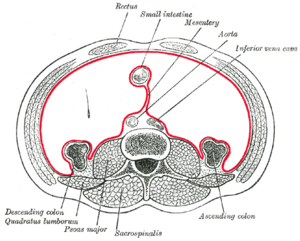Mesenteric
| Mesentery | |
|---|---|

Horizontal disposition of the peritoneum, in the lower part of the abdomen: The peritoneum and mesentery are marked with red.
|
|

Vertical disposition of the peritoneum: Main cavity, red; omental bursa, blue
|
|
| Details | |
| Identifiers | |
| Latin | Mesenterium |
| MeSH | A01.047.025.600.451 |
| TA | A10.1.02.007 |
| FMA | 7144 |
|
Anatomical terminology
[]
|
|
The mesentery (/ˈmɛzənˌtɛri/) is a continuous set of tissues which is formed by the double fold of peritoneum that attaches the intestines to the wall of the abdomen. The term mesentery is used for the small intestine; and mesenteric organ is sometimes used to refer to the rest of the mesentery that incorporates the mesocolon, mesoappendix, mesosigmoid and mesorectum. It has been proposed for reclassification as an organ due to research at the University of Limerick in the 2010s.
Conventional teaching had described the mesocolon as a fragmented structure with all the named parts—the ascending, transverse, descending, and sigmoid mesocolons, mesoappendix, and mesorectum as separately terminating their insertion into the posterior abdominal wall. In 2012, following detailed microscopic and electron microscopic examinations, the mesocolon was shown to be a single, continuous structure that commenced from the duodenojejunal flexure and extended to the level of the distal mesorectum. This simpler concept has enabled substantial advances to be made in different aspects of surgery on the colon and rectum. It has also had implications for sciences related to surgery, anatomy, and development.
The word "mesentery" and its New Latin equivalent mesenterium (/ˌmɛzənˈtɛriəm/) use the combining forms + , ultimately from ancient Greek μεσεντερον (mesenteron), from (mésos, "middle") + (énteron, "gut"), yielding "mid-intestine" or "midgut". The adjectival form is "mesenteric" (/ˌmɛzənˈtɛrᵻk/).
...
Wikipedia
